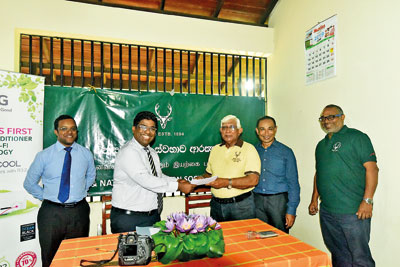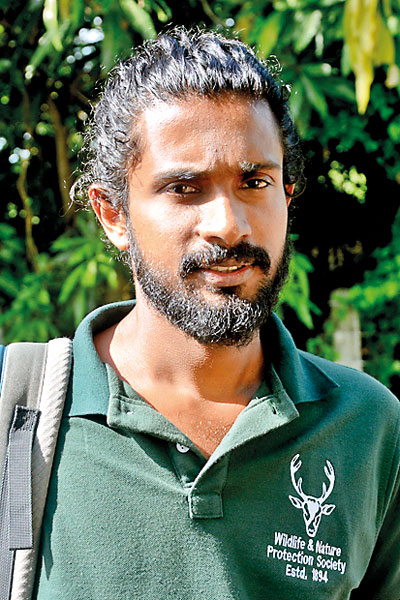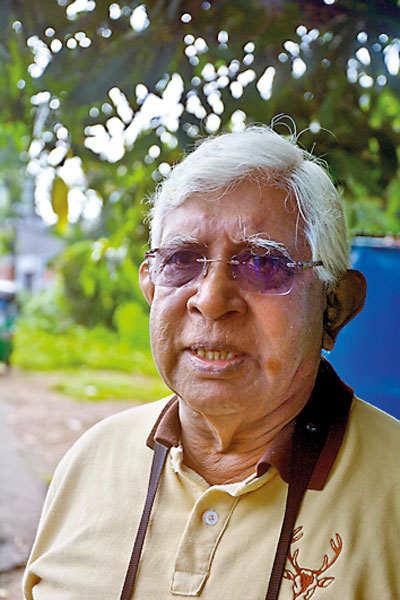News
Giving back life to the ‘Green Isle’

At the soft-launch of the ‘Green Isle’ project on June 6 – (from left) Abans Brands Manager Ruwan Gunasekera; Abans Director Buddhika Dharmawardena; Project Chair Prof Lakdas Fernando; WNPS President Sriyan de Silva Wijeyeratne; and WNPS General-Secretary Jehan CanagaRetna. Pix by Ishanka Sunimal
Across a floating bridge made of barrels, there is an island being smothered by wel-atha, where slowly a ‘revival’ is taking place so that soon it will be a haven for all those creatures being pushed out of their habitats in Colombo’s suburbs.
Not far to travel, the ‘Green Isle’ surrounded by canals, where lurks the geta kimbula (salt-water crocodile), is within the protected Bellanwila-Attidiya Sanctuary, and the ‘main but not exclusive target’ of this project is the Purple-faced Leaf Monkey, an endemic species which conservationists fear will become extinct. (The sub-species found in the Colombo area is known as ‘Nestor’.)

Project Coordinator Amila Perera
Sited very close to the Animal Rehabilitation Centre of the Department of Wildlife Conservation (DWC), where shelter, succour and treatment are provided to many a creature which has fallen victim to the hazards of urbanization, the area is serene when we get there on Wednesday.
Not only are troops of these Purple-faced Leaf Monkeys suffering from habitat loss and non-availability of food trees, they are also the ‘highest’ single species brought in regularly with accident injuries to the Animal Rehabilitation Centre.
The floating bridge lies next to the Pitawella Bodhiya, just before the ‘bunt’ bridge across a canal which is part of a network, with Bolgoda Lake as its heart. Men, women and children stop by to invoke blessings, light lamps and joss sticks at this bodhiya or sit in contemplation of the surroundings as heavy traffic rushes by.
The five-year ‘Green Isle’ Project for ‘habitat restoration for species conservation’ is being implemented by the Wildlife and Nature Protection Society (WNPS) in support of the DWC, with the sponsor being Abans. WNPS’s Prof Lakdas Fernando is managing this six million rupee project, while its Coordinator is Amila Perera.
When fully developed, the isle will have an abundance of food trees for Nestor and also other creatures including birds, becoming a safe home for wild animals living under threat in this suburban area of Colombo.
Having tentatively crossed the floating bridge, overhauled from its original derelict state, accompanied by Prof Fernando, we step onto thick black soil which insistently clings to our footwear and pass small heaps of refuse such as polythene, bottles and more dumped over the years in this canal network and washed ashore.
Along a pathway cleared and cut by a backhoe, slim saplings such as kumbuk, kiri-palu and madang have been newly-planted, and Prof Fernando explains that the project was launched on June 6 without much ceremony. The official launch in August will witness more than a thousand trees being planted on that day.
As an Open-billed Stork rests atop a tree and a Cormorant spreads its wings to catch the morning sunshine, he laments that this habitat was “totally destroyed” by land-grabs, filling of marshy land and garbage dumping. The canals have become clogged with salvinia and the land is struggling for survival under the massive and aggressive invasion by wel-atha.
“The natural indigenous vegetation is being annihilated by wel-atha (also known as pond apple),” says Prof Fernando, pointing out that this is depriving the area’s creatures, particularly the Purple-faced Leaf Monkey of their food. “Earlier, even rare migrants such as the Glossy Ibis used to visit this area, but now even our very own Black-headed Ibis has stopped nesting here.”

Prof Lakdas Fernando
Reiterating that Sri Lanka’s National Parks are being destroyed due to over-visiting and the indiscipline of visitors, Prof Fernando says it is not only the charismatic animals such as the elephant and the leopard in the wilds that we need to safeguard. Creatures in the urban and suburban areas may not be charismatic but we should protect them to keep alive our ecosystems and for our very own survival.
A visit to the DWC’s Animal Rehabilitation Centre across the road breaks your heart, he says with much emotion, for here you find battered and bruised creatures including those who have been electrocuted. Nestor is there in numbers as well as Fishing and Rusty-spotted Cats, eagles in their variety – Brahminy Kites, Wide-bellied Sea Eagles and Serpent Eagles – and more.
“At a time when Sri Lanka is applying to get the stamp of ‘Ramsar City’ for Colombo, we thought we would focus on this area,” says Prof Fernando, adding that the “push” in this direction came after a poignant presentation on ‘Saving Nestor’ by Dr Jinie Dela.
The target is the complete rehabilitation and habitat enrichment for species conservation of the ‘Green Isle’ after a major clean-up of wel-atha and other invasives. A walking trail around the ‘Green Isle’ is already taking shape.
He said that technical and advisory support, as an “in-kind” contribution to the project is from Dr Siril Wijesundara and Dr Dela.
Explaining that all the heavy machinery was provided by the Sri Lanka Land Reclamation and Development Corporation (SLLRDC) free of charge, Prof Fernando added that the SLLRDC General Manager K Rajapakse and his team of engineers gave a big boost to the initial work of the project.
The WNPS is not without earlier experiences in this challenging arena, for in 2015 it successfully launched, under the direction of Prof Fernando, the ‘Restoration Of A Rainforest’ (ROAR) on Diyakotha Kanda in Badureliya in the Hedigalla-Dikhena area which comes under the purview of the Forest Department.
| Importance of ‘Green Isle’ The 50-hectare ‘Green Isle’ within the 372-ha Bellanwila-Attidiya Sanctuary, directly east of Attidiya and south of the Bellanwila temple, is within the upper catchment of the Bolgoda basin. This sanctuary is home to more than 150 bird species, both migratory and endemic; more than 20 species of mammals including the Mouse Deer, Otter, Fishing and Rusty-spotted Cat and many bat species. The largest predators seen in the area are the salt-water crocodiles and rock pythons. In the areas surrounding this isle are troops of endemic Purple-faced Leaf Monkeys (Nestor) which are suffering due to habitat loss and non-availability of food trees. This is also a flood-retention area for the highly-populated towns of Boralesgamuwa, Pepiliyana, Kesbewa and Dehiwala-Mount Lavinia. The objectives of the ‘Green Isle’ Project are: n To make the ‘Green Isle’ the urban green lungs of the area. n Habitat enrichment by planting suitable native species and gradual replacement of invasive species (such as wel-atha and acacia) through under-brushing and gradual removal. There will also be a restoration of mangroves which had been there earlier, but no more. n De-siltation and clearing of small canals with the restored banks being planted with suitable Wet Zone shrubs, trees and creepers. n Controlling invading water weeds and others (including salvinia and water hyacinth or Japan-jabara) through periodicclearing as open water bodies are essential for water birds such as teals, ducks, cormorants, grebes and purple herons and rare migrant species such as the Glossy Ibis and Combed Duck. n Regular monitoring of water quality which is an essential part of wetland management to support the DWC in detecting whether garbage and also effluents from garment, paint and other industries are being dumped here.
| |

Soon to be a haven for all those creatures being pushed out of their habitats in Colombo’s suburbs

